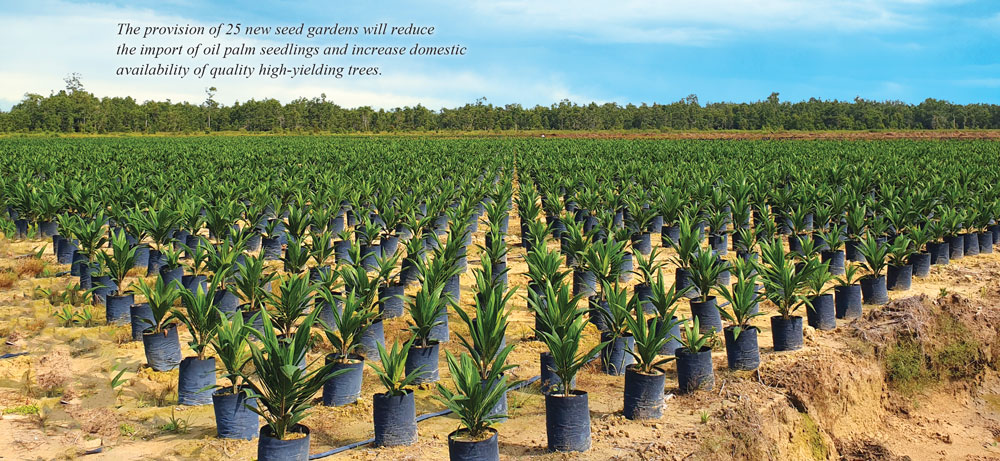



India approved its ambitious National Mission on Edible Oil-Oil Palm (NMEO-OP) in August 2021 to promote oil palm cultivation and help the country achieve self-sufficiency in edible oils. The NMEO-OP will be implemented over five years, from 2021-22 to 2025-26, with a special focus on the north-eastern states and the Andaman & Nicobar Islands.
Cultivation under the NMEO-OP will bring an additional 0.65 million ha under oil palm, of which 330,000 ha will be in the north-eastern states and 320,000 ha over the rest of the country. The NMEO-OP, with a total outlay of Rs.110.4 billion will allocate Rs.58.7 billion to the north-eastern states.
India is the world’s largest importer of edible oils, having to rely on this to meet its requirements. In 2020-21, it imported about 13.3 million tonnes of edible oils, costing around Rs.800 billion. About 9 million tonnes of palm oil are imported every year to the tune of Rs.400 billion. The palm oil share of edible oils imports is about 56%, followed by soybean oil at 27% and sunflower oil at 16%.
In 2020-21, domestic production of edible oils was 12.3 million tonnes while consumption exceeded 25 million tonnes (Table 1). The per capita consumption, which was 15.8kg per annum in 2012-13, stands at 19kg currently.
The government has been making continuous efforts to increase the planted area under oil palm and improve the production of palm oil, in order to reduce the import burden. Various schemes have been implanted since 1991-92:
These schemes were implemented in 13 states – Andhra Pradesh, Telangana, Chhattisgarh, Tamil Nadu, Kerala, Gujarat, Karnataka, Odisha, Mizoram, Nagaland, Assam, Arunachal Pradesh and Manipur, with a funding ratio of 60:40 for general states and 90:10 for the north-eastern and hill states.
As a result of these developmental efforts, the oil palm planted area grew from 8,585 ha in 1991-92 to 0.4 million ha in 2020-21. Over the same period, the production of fresh fruit bunches (FFB) increased from 21,000 tonnes to 1.7 million tonnes in 2020-21. Crude palm oil (CPO) output went up from 1,000 tonnes to 0.3 million tonnes.
Andhra Pradesh, Telangana and Kerala are the main oil palm growing states, accounting for 98% of total production. Karnataka, Tamil Nadu, Odisha, Gujarat and Mizoram also have a sizable area under oil palm. Recently, Arunachal Pradesh, Assam, Manipur and Nagaland initiated large-scale planting programmes.
In 2020, the reassessment committee of the Indian Council of Agricultural Research (ICAR)-Indian Institute of Oil Palm Research (IIOPR) found that there was potential for oil palm cultivation on 2.8 million ha nationwide in 284 districts (Table 2). Of this, 1.8 million ha are in general states and about 1 million ha in seven north-eastern states.
The current planted area in the north-east is about 38,992 ha against the assessed potential of close to 1 million ha. In 2020-21, CPO production was about 0.3 million tonnes, obtained from almost 0.2 million ha of the country’s fruiting area.
Mission targets
Domestic palm oil production needs to harness the strengths of the oil palm’s features – it is a perennial tree species with the highest edible oil yield potential. Capital investment is required to promote cultivation and encourage planting in a cluster approach and through contract farming.
However, both the industry and farmers have baulked at the cost of planting and materials, as well as that of manuring, irrigation and maintenance of the planted area four years before harvesting can start. In the hilly north-eastern states, additional investment is required for land preparation, road connectivity and the setting up of mills, among other aspects.
Considering the growing domestic demand for edible oils, the staggering deficiency and the cost to the exchequer on account of imports, the urgency of up-scaling the oil palm planted area is of significant national interest. The NMEO-OP was approved to facilitate this.
The implementing stakeholders comprise the State Department of Agriculture, State Department of Horticulture, Central Agriculture University, ICAR institutions, Crop Development Directorates, State Agriculture University, Krishi Vigyan Kendra, central agencies/cooperative societies, oil palm processors’ associations and government television stations.
One way of raising the production of edible oilseeds and edible oils is by expanding the area under oil palm and increasing CPO production. At present, against a total potential area of about 2.8 million ha, only 0.4 million ha is under cultivation. The main targets of the NMEO-OP are therefore to:
Salient features of the NMEO-OP
Under the Oil Palm Act of every state, a long-term agreement will be made with major players in the industry to achieve area expansion and set up mills. The industry has agreed to match the government’s investment in the sector. This will cover seed nurseries, supply of seedlings, technical back up, setting up of mills, FFB purchase centres and the training of farmers.
There will be ample scope to engage oil palm processors, cooperative societies, associations and Farmers Producers Associations through state governments. In addition, the ICAR, Central Agriculture University and State Agriculture University will be brought in for technical back up, development of new technologies, research infrastructure and setting up of seed gardens and nurseries. Assistance for various interventions in oil palm development has been increased under the Mission, with a special package for the north-eastern states.

Interventions under the NMEO-OP
Farmers will be given more assistance with planting materials, inputs like fertilisers and pesticides, micro-irrigation (drip), water harvesting ponds, bore wells, farm machinery and harvesting tools. Seed gardens and nurseries will be established to assure a supply of good planting material. There will also be support for inter-cropping for the first four years of cultivation to compensate farmers for income loss during the non-fruiting period. The industry will have help in establishing mills in the north-eastern states and to enter into long-term agreements to buy FFB from farmers and to process FFB.
Viability Gap Payment (VGP) Mechanism
For the first time in the history of oil palm development in India, the government has committed to declaring a Viability Price (VP) for FFB every year up to 2037, for price assurance to protect the farmers’ interests. By fixing the VP, the government will guarantee a benchmark price for FFB based on a transparent and rational formula.
At present, there is no such government support to insulate farmers from volatility in prices. The new mechanism will protect the interests of farmers by ensuring remunerative returns and building their confidence to undertake oil palm planting.
The industry will pay 14.3% of the average monthly CPO price from Nov 1, 2021 to Oct 31, 2028. This payment will then be raised by 0.25% every three years from Nov 1, 2028, to Oct 31, 2037.
To give impetus to oil palm development in the north-eastern states and the Andaman & Nicobar Islands – especially because of the terrain, tough conditions and need for investment – the payment will be shared between the industry and the government.
Instead of the FFB payment of 14.3% of the CPO price from Nov 1, 2021, the industry will pay 12.3% of the monthly average CPO price; the government will meet the difference of 2% of the CPO price as a special north-eastern region and Andaman & Nicobar Islands payment. This is to ensure that the farmers of the two areas are paid on par with the rest of India.
Currently, under the Oil Palm Act/Regulations/Orders, state governments fix the price of FFB, which is paid by the industry to the farmers. The VGF and special payments due to the farmers are proposed to be paid by Direct Benefit Transfer into the farmers’ bank accounts. As this is a support mechanism for farmers, it has been proposed that 100% of the VGF and special payments for the north-eastern region and the Andaman & Nicobar Islands be made by the government.
Government funding for the NMEO-OP will be retained until 2025-26, with a sunset clause to take effect from November 2037. Those farmers already cultivating oil palm will also be considered for the VGF, along with future growers, to enhance confidence in oil palm development.
The special package and assistance for the north-eastern states will change the socio-economic status of farmers, as well as open up employment opportunities in palm oil mills that are established alongside infrastructure development. The provision of 25 new seed gardens will reduce the import of oil palm seedlings and increase domestic availability of quality high-yielding trees. Bringing more than 0.5 million ha under drip irrigation in newly-planted areas will conserve water and increase the FFB yield.

Oil palm requires a high investment during the first four years of growth, without providing any economic returns. The increased subsidy for planting material, maintenance, inter-cropping inputs and harvesting tolls will reduce the farmers’ burden and will help in large-scale adoption.
The NMEO-OP will strengthen R&D activities by ICAR, international cooperation in germplasm exchange, capacity building and development of dwarf varieties with a high yield and oil content. The Mission will lead to a marked increase in oil palm’s contribution to the edible oils pool, from 2% now to 6% by 2025-26 and 12% by 2029-30.
Kudos to the government for coming up with a long-term, simple, transparent and reliable formula for fixing the FFB price, which is acceptable to farmers, processors and state governments. The VP formula will bring parity in FFB prices in the north-eastern states, where prices have been low compared to general states. It will be a win-win situation for both farmers and processors in this area. The decision to announce the VP of FFB in November each year through the Oil Palm Act, will also raise the confidence of farmers.
Dr Anupam Barik
Former Additional Commissioner (Crops)
Department of Agriculture & Farmers Welfare
Government of India, New Delhi
The author in currently working as Advisor-Palm Plantation at Ruchi Soya Industries Ltd, Noida, UP. The information on NMEO-OP collected from DA&FW is duly acknowledged.